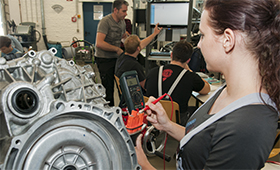More female bakers and female painters and varnishers
BIBB analysis – growth in the proportion of women in “male occupations”
19/2016 | Bonn, 26.04.2016

A current BIBB analysis conducted on the occasion of the 2016 “Girls’ and Boys’ Day” has shown that things are beginning to move slowly but surely. In around 80 of 105 “male occupations” investigated by the Federal Institute for Vocational Education and Training (BIBB), the proportion of female trainees has risen over the past twelve years. The survey includes all of the 25 most popular occupations. Although the increases are not very large and average out at around 0.2 percentage points per year and occupation, the trend is unmistakeable. By 2015, the annual rises in proportions of young women had amounted to total average growth of over two percent. “Male occupations” are defined as occupations in which the proportion of men exceeds 80%. Typical male occupations are, for example, to be found within the construction, metal working and electrical sectors.
Three craft trade occupations which are amongst the most popular of “male occupations” have suceeded in acquiring more female trainees. Between 2004 and 2015, the proportion of young women in the occupation of “baker” rose by 7.7% to reach 25.9%. Corresponding increases achieved in the occupations of “painter and varnisher” and joiner” were 6.5% to 15.9% and 5.0% to 12.2% respectively. The increase in the amount of women in the occupation of “baker” is even large enough to mean that this occupation no longer forms part of the category of “typical male occupations”.
Women who opt to enter training in typical “male occupations” are rewarded with a training allowance which on average is higher than that paid in typical “female occupations”. The same is not true for men who embark upon typical “female occupations”, in which average allowances are lower.
Because a high income tends to be of somewhat greater significance for young men than for young women, the lower levels of remuneration are reason enough for the former to avoid typical “female occupations”. Whereas, therefore, more women are gaining foothold in “male occupations”, no reciprocal tendency can be observed for young men. The average proportion of young men in typical “female occupations” has scarcely changed in the last twelve years. Typical “female occupations” are, for example, medical assistant, dental or veterinary assistant, florist, hairdresser and beautician.
The positive exceptions in the development of the proportion of men in “female occupations” include the two occupations which pay a training allowance at least above the average of all occupations – judicial clerk and laboratory technologist in the dairy industry. The amount of men in both of these occupations has increased significantly since 2004 by 0.4 percentage points per occupation and year on average.
As far as BIBB President Friedrich Hubert Esser is concerned, the BIBB analysis shows that initiatives such as “Girls’ and Boys’ Day” need time. “We still see that many training occupations receive one-sided demand from one gender only. It is clear that plenty of patience and time will be required in order to counter such imbalances. On the other hand, however, the results reveal that things are starting to change.”
The BIBB analysis covered occupations which had had at least 100 new training contracts in the year 2004.
Further results are available in the data evaluation prepared for “Girls’ and Boys’ Day 2016”. This is entitled: “Male occupations are no longer quite so typical for men. Developments in the proportion of women in occupations dominated by men from 2004 to 2015”. This analysis may be downloaded (in German) free of charge from the BIBB website at www.bibb.de/de/8475.php.
Picture material is available at www.bibb.de/pressefotos.
Reprint free of charge – voucher copy requested.